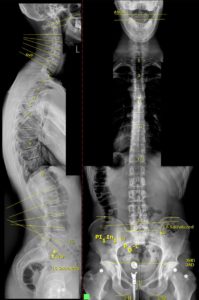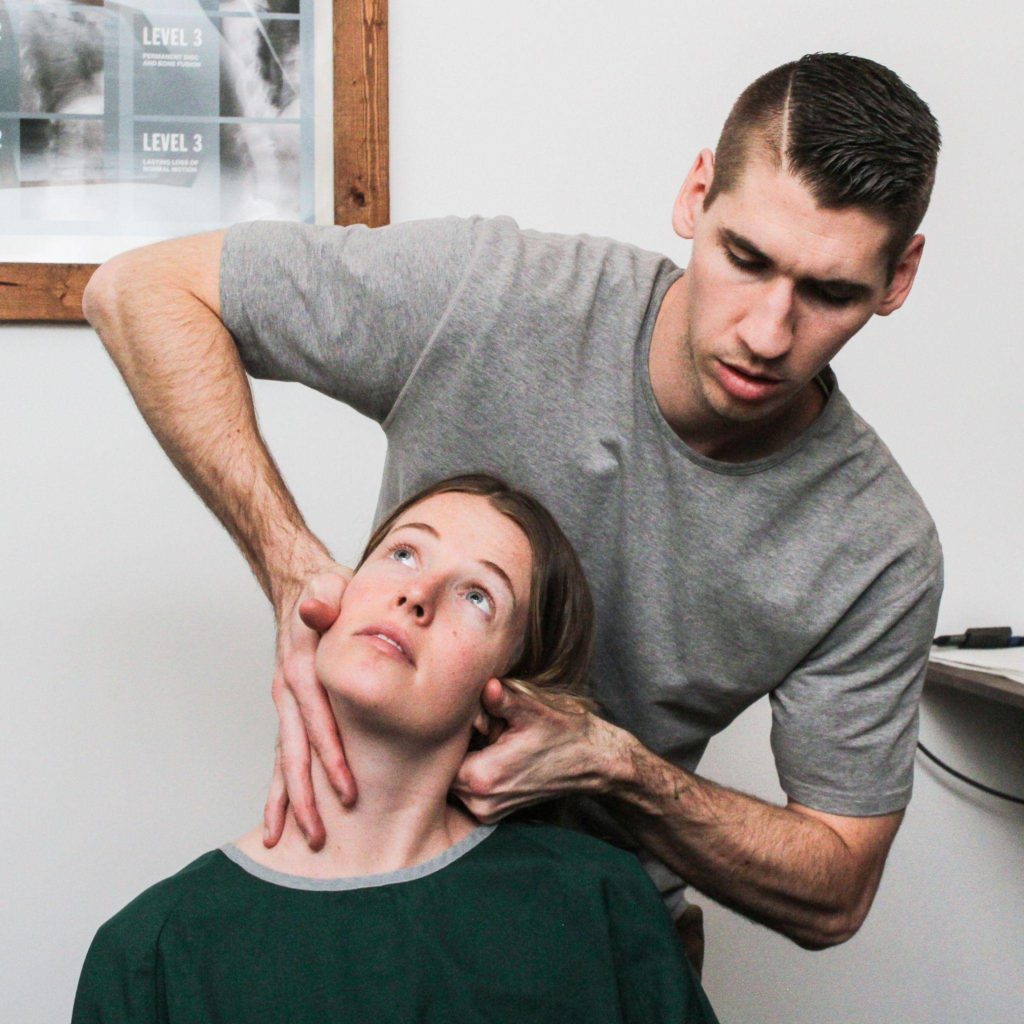Known as the Gold Standard of chiropractic, the Gonstead Method was founded by Clarence S. Gonstead (1898-1978). Dr. Gonstead first encountered chiropractic care after suffering an acute case of rheumatoid arthritis. After visiting multiple medical doctors, it was finally a chiropractor that helped him in a way that he deemed “miraculous.” With a background in mechanical engineering obtained before chiropractic school, Clarence Gonstead is credited with taking chiropractic from a back-alley bone setting profession to a logical and bio-mechanically sound system of restoring health to the human body.
Dr. Gonstead owned and operated the world-famous Gonstead Clinic in Mount Horeb, Wisconsin. The two-level facility boasted 29,000 square feet, 11 adjusting rooms, a complete chemistry laboratory, research facilities, and various seminar rooms. The Gonstead Clinic also hosted its own hotel and landing airstrip on campus for the vast amount of people Dr. Gonstead would see from all over the globe. It is estimated that in his 51 years of practice, he saw 1.2 million patients, working on occasion 23 hours a day. The clinic is still there today and is the host of multiple Gonstead seminars each year.
The Gonstead Method of chiropractic focuses on the structural foundation of the body (the pelvis) as well as the intervertebral discs. As an engineer, Dr. Gonstead fully understood that any slight deviation in a foundation will cause deviation in the structures above. A Gonstead doctor will be concerned with the leveling of the pelvis, the intervertebral disc space, nerve dysfunction, and motion of each segment of the spine to determine areas of subluxation. Gonstead adjustments are designed for maximum effect on the discs, while also working to restore normal alignment and motion.
The Gonstead Method is the most specific technique in chiropractic. Using 5 methods of assessment before every adjustment ensures that your doctor knows exactly which vertebra needs to be adjusted as well as the exact biomechanics needed for the correction.
What are full spine radiographs?

Full spine radiographs (or full spine x-rays) are an integral assessment tool in any Gonsted office. Gonstead used his engineering background to create an intricate x-ray marking system that turns your spine into a blueprint for your doctor. You will see a lot of lines, angles, numbers, and letters on your x-ray. These markings tell the doctor how to adjust the vertebra in question down to the angle, depth, and force needed. A Gonstead doctor completes this line analysis on your images and refers to it before every adjustment to ensure they are delivering the most specific adjustment for your body. Like fingerprints, the alignment of your spine is completely unique to you. No two spines look the same, imagine adjusting them like they were all the same!
Imagine going to a dentist and not getting x-rays. Sure, they can see the plaque on your teeth and remove it. They can see the state of your gums and make recommendations on gum health. But they would only be seeing surface level. Imagine all the information that they would be missing out on… bone loss, decay occurring beneath the surface, abscess, etc.
The same thing happens when you let someone adjust your spine without taking X-rays. When a Gonstead Doctor takes x-rays of your spine they are looking at the angle, rotation, and position of each one of your vertebra. They are looking at bone density, disc health, fractures (new and old), and anomalies. They provide vital information to your doctor.
Full spine radiographs are a part of the 5-step Gonstead analysis. The remaining 5 steps include instrumentation, motion palpation, static palpation, and visualization of posture and signs of inflammation near the spine.
What is a Nervoscope?

The nervoscope is another integral tool of the Gonstead method. This tool is glided up and down the entire spine and uses thermography to detect areas of inflammation and nerve pressure that can point to subluxation. The nervoscope is used before every adjustment and after each adjustment to ensure that the signs of inflammation were cleared.
This tool, along with the other 4 methods of the Gonstead analysis let Gonstead doctors completely avoid the shotgun approach of chiropractic. A Gonstead doctor never wants to approach chiropractic in the “top-down” approach where all involved vertebrae are forced into motion with twisting and popping. The 5 steps of analysis help your doctor differentiate a primary subluxation from its compensation (secondary misalignment). Rest assured that you are only getting necessary adjustments in a Gonstead office.
What is a Hydraulic Hi-Lo Table?

In the same way that Gonstead doctors understand that you can’t use one form of analysis to properly locate a true subluxation, they know that you cannot use one single table for every adjustment. Each vertebra is unique in its function, motion, size, and shape. Therefore each adjustment to the different vertebra of the spine must look different as well. A Gonstead office will have a number of tables including a pelvic bench, a cervical chair, a knee-chest table, and a hydraulic hi-lo table to ensure that you are comfortable and receiving a specific adjustment every time.
The hi-lo table was designed with Clarence Gonstead in mind. It can be used for a multitude of adjustments. It raises and lowers to help people who are in pain or cannot move around easily get into a comfortable position for their adjustment. It also has pieces that drop-down allowing for pregnant patients to lay prone for their adjustments.
What is a Lumbar or Pelvic Bench Adjustment?

The pelvic bench (along with the other tables in the room) was custom ordered by your Gonstead doctor to fit their exact height. This table is most commonly used for lumbar and pelvic adjustments. The height of the table (perfectly fit for your doctor) allows the doctor to stabilize your body before the adjustment occurs to avoid any rotation in your spine. All Gonstead adjustments are push or pull maneuvers, rotation is not used. The table is soft and allows for a very specific adjustment to the lower parts of your spine.
What is a Knee Chest Table?

Easily the most asked about table in the room, the knee-chest table is very powerful. As suggested by its name, it is a table that is kneeled on so only the knees and chest of the patient are touching it. This allows for the anterior side of the discs to open up to help your Gonstead doctor properly set the vertebra on the disc. It allows for a deeper adjustment than the other tables in the room. Your Gonstead doctor knows when it is appropriate to use. This table is also great for pregnant mamas and is very comfortable!
What is a Cervical Chair?

The cervical chair is designed for adjustments in the neck. Dr. Gonstead perfected his cervical adjusting technique after watching his adjustments under fluoroscopic imaging. The chair is designed to help lift the vertebra being adjusted as a ‘hyperflexion misalignment’ is common in the cervical region. Dr. Gonstead was of the opinion that this was the only way to adjust the cervical spine.
The Gonstead cervical adjustment is unique in its specificity. Most manual chiropractors will utilize the broader areas of the metacarpal-phalangeal or inter-phalangeal joints to adjust the neck (they use their whole finger as a contact point). A Gonstead chiropractor will use the distal-lateral-anterior tip of the index finger for C2 down to the upper thoracic vertebrae, as well as the analogous portion of the thumb for the cervical chair Atlas contacts. As you can guess, this provides for a much more specific adjustment.
While one hand of your doctor is making the correction, the other hand is stabilizing the rest of the neck to ensure that there is no rotation or motion in any other vertebra other than the single vertebra being targeted for the adjustment.
While it may be a different experience for you to be adjusted sitting up, we can assure you that all of our patients find this technique less intimidating and more comfortable than the typical chiropractic cervical adjustment. This technique requires no rotation, making it safer. It also requires significantly less motion to your neck. You’re in good hands with a well-trained Gonstead chiropractor!
So what is the difference between typical chiropractic care and Gonstead chiropractic care?
Specificity. In a Gonstead Chiropractic office, you will get a thorough assessment, full spine images, and the most specific adjustment in chiropractic every time. Because Gonstead chiropractors are so specific, they can usually get results faster than the average chiropractor.
You will be hard-pressed to find another technique in chiropractic more knowledgeable about your nervous system, how to regulate it, biomechanics of the human spine, x-ray analysis, or how to deliver a specific adjustment to a single bone in the spine.
You will feel more confident in your investment because your doctor will be confident in their work. There is no guesswork in Gonstead chiropractic.
Gonstead really is unlike any other technique in chiropractic. There is no shotgun approach to this technique. Everyone needs to experience the Gonstead difference. Your nervous system will thank you.
Source: Robert W. Herbst, D.C. Gonstead Chiropractic Science & Art; The Chiropractic Methodology of Clarence S. Gonstead, D.C. Sci-Chi Publications, 1980.
“Gonstead Clinical Studies Society.” Gonstead Clinical Studies Society, https://www.gonstead.com/overviews-of-gonstead-technique/.


